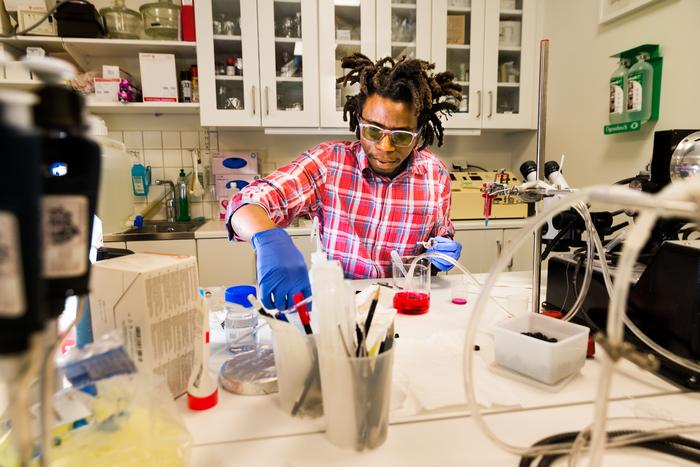A cochlear signal, the exact role of which has been unclear since its discovery around 70 years ago, probably gives the brain information on whether the ear is functioning normally or not. This is the conclusion of a study from Linköping University, Sweden. Its findings are an important piece of the puzzle in explaining what happens in the ear in hearing impairment caused by harmful noise, and may in the long run contribute to diagnosing noise-induced hearing injury.

Credit: Thor Balkhed/Linköping University
A cochlear signal, the exact role of which has been unclear since its discovery around 70 years ago, probably gives the brain information on whether the ear is functioning normally or not. This is the conclusion of a study from Linköping University, Sweden. Its findings are an important piece of the puzzle in explaining what happens in the ear in hearing impairment caused by harmful noise, and may in the long run contribute to diagnosing noise-induced hearing injury.
When the ear is exposed to loud sounds, as at a concert or when being in a noisy environment, hearing can be temporarily impaired. Being repeatedly exposed to loud sounds may cause permanent damage to hearing. There is research to indicate that more than one billion young people are at risk of damaging their hearing by listening to loud music with headphones and at venues. But although noise damage is a major cause of impaired hearing, the exact mechanisms are largely unclear. Pierre Hakizimana at Linköping University is one of the researchers aiming to find out how these damages occur and whether they can be prevented.
The inner ear, or cochlea, has around 15,000 hair cells. When hit by sound waves, the hair cells transform the vibrations to electric nerve signals. These signals are led to the brain, which interprets them, and not until then can we hear the sound. The hair cell signal consists of two parts, called AC and DC. The AC signal is well researched. It gives the brain information on sound loudness and frequency, i.e. how high or low pitched the sound is. But the DC signal has remained something of a mystery. Ever since its discovery some 70 years ago, researchers have been wondering what its function could be.
When measuring the electrical signals from the cochlea hair cells, the DC signal is noticeable as it causes a slight shift in the AC signal in either a positive or a negative direction. Various studies trying to characterise the DC signal have come to different conclusions as to its polarity. In the current study, Pierre Hakizimana shows that DC signal polarity changes from positive to negative when the cochlea has been exposed to harmful noise. In other words, the signal can provide an indication of ear health status.
“It seems like this signal could be a way for the body to inform the brain whether the ear is healthy or not, and in that way facilitate the brain’s ability to decode faint sounds. The brain can amplify a weak signal from the cochlea. If informed that the ear isn’t functioning normally, the brain doesn’t have to spend resources trying to improve the signal to decode sound from an injured ear,” says Pierre Hakizimana, principal research engineer in the Department of Biomedical and Clinical Sciences at Linköping University.
This discovery may hopefully contribute to new research on how the DC signal could be used to diagnose hearing loss caused by harmful noise. This has so far not been solved, as it has not been known how to interpret this signal, or how to reliably isolate and measure it in humans.
In his study, Pierre Hakizimana also shows that the DC signal is created by potassium ion channels releasing potassium ions through hair cell membranes.
The research was funded by Stiftelsen Tysta Skolan.
The article: The summating potential polarity encodes the ear health condition, Pierre Hakizimana, (2023), Cellular and Molecular Life Sciences, 80, 163 (2023), published online 24 May 2023, doi: https://doi.org/10.1007/s00018-023-04809-5
For more information, please contact:
Pierre Hakizimana, principal research engineer, [email protected], +46 13 28 69 64
Journal
Cellular and Molecular Life Sciences
DOI
10.1007/s00018-023-04809-5
Method of Research
Experimental study
Subject of Research
Animal tissue samples
Article Title
The summating potential polarity encodes the ear health condition,
Article Publication Date
24-May-2023
COI Statement
The author declares no competing interests.




